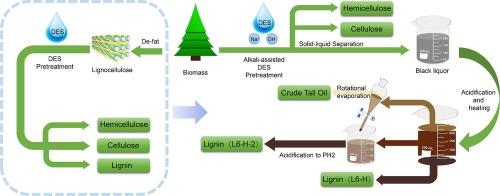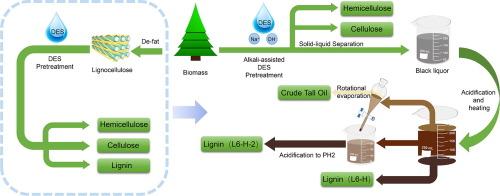利用碱助深共晶溶剂对针叶生物质进行高效绿色预处理,用于高油生产和木质素组分分离
IF 9
1区 工程技术
Q1 ENGINEERING, CHEMICAL
引用次数: 0
摘要
随着人口扩张和工业发展对全球能源需求的不断增长,植物资源的有效增值对于实现碳中和和碳转化至关重要。虽然通过各种新颖的预处理方法在木质纤维素生物质的综合利用方面取得了重大进展,但以木质纤维素材料为原料分离脂质,同时分离三种主要成分,特别是从富含脂质的针叶树中分离脂质仍面临许多挑战。本文介绍了一种碱辅助深度共晶溶剂(DES)预处理的新方法,并结合亚硫酸盐制浆副产物塔尔油的生产工艺,重点研究了从黑液中生产塔尔油和木质素组分。结果表明,最佳酸化条件为pH = 6,反应时间为120 min,在高温条件下,亚油酸含量为79.9%,异枞酸含量为28.5%,脱氢枞酸含量为32.3%。在弱酸性条件下,一些木质素受到高温的影响,导致形成小木质素碎片。但在深共晶溶剂(DES)的保护下,仍保留了大量的β-O-4键,有利于后续降解。这种新设计的生物质原料预处理工艺为实现高效的绿色脱脂和分离木质纤维素材料的三种主要成分提供了有价值的指导。本文章由计算机程序翻译,如有差异,请以英文原文为准。


Efficient green Pre-Treatment of coniferous biomass using Alkali-Assisted deep eutectic solvents for tall oil production and lignin component separation
With the growing global energy demand due to population expansion and industrial development, the efficient valorization of plant resources is critical for achieving carbon neutrality and carbon conversion. While significant progress has been made in the comprehensive utilization of lignocellulosic biomass through various novel pre-treatment methods, using lignocellulosic materials as raw materials to separate lipids while separating the three main components, especially from lipid-rich coniferous trees, still faces many challenges. This article presents a novel pre-treatment approach using alkali-assisted deep eutectic solvents (DES) in combination with the tall oil production process derived from sulfite pulping by-products, focusing on the production of tall oil and lignin components from black liquor. The results indicate that the optimal acidification conditions are a pH of 6 and a reaction time of 120 min at high temperature, yielding the best crude tall oil with linoleic acid at 79.9%, isoabietic acid at 28.5%, and dehydroabietic acid at 32.3%. Under weak acidic conditions, some lignin is affected by high temperatures, leading to the formation of small lignin fragments. However, under the protection of deep eutectic solvents (DES), a large amount of β-O-4 bonds is still preserved, which is beneficial for subsequent degradation. This newly designed pre-treatment process for biomass raw materials offers valuable guidance for achieving efficient green defatting and separation of the three main components of lignocellulosic materials.
求助全文
通过发布文献求助,成功后即可免费获取论文全文。
去求助
来源期刊

Separation and Purification Technology
工程技术-工程:化工
CiteScore
14.00
自引率
12.80%
发文量
2347
审稿时长
43 days
期刊介绍:
Separation and Purification Technology is a premier journal committed to sharing innovative methods for separation and purification in chemical and environmental engineering, encompassing both homogeneous solutions and heterogeneous mixtures. Our scope includes the separation and/or purification of liquids, vapors, and gases, as well as carbon capture and separation techniques. However, it's important to note that methods solely intended for analytical purposes are not within the scope of the journal. Additionally, disciplines such as soil science, polymer science, and metallurgy fall outside the purview of Separation and Purification Technology. Join us in advancing the field of separation and purification methods for sustainable solutions in chemical and environmental engineering.
 求助内容:
求助内容: 应助结果提醒方式:
应助结果提醒方式:


